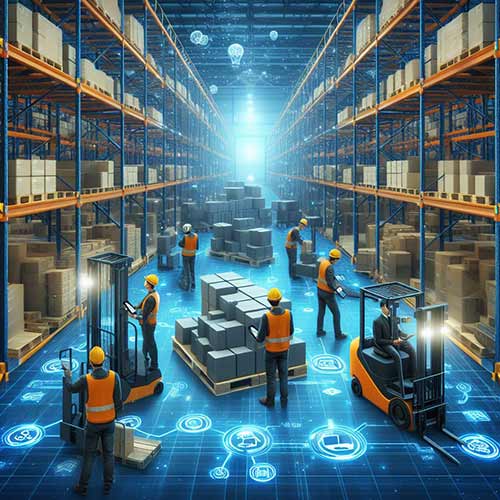What is Preventive Maintenance (PM)?
Preventive maintenance is a planned, recurring program of inspections, adjustments, lubrication, parts replacement, and safety checks that keeps warehouse and material-handling equipment operating reliably. Instead of waiting for breakdowns, PM finds and fixes small issues before they become big failures that halt production, damage inventory, or create safety risks. In warehousing, PM typically covers pallet racking and shelving, conveyors and sortation, dock equipment and doors, forklifts and reach trucks, mezzanines, safety barriers/guarding, and controls.
Compliance note: OSHA’s warehousing guidance explicitly calls for inspecting and maintaining shelving and racking to prevent collapse, and it emphasizes proper storage and guarding practices—areas PM programs directly address. OSHA+1
How Preventive Maintenance Benefits a Company
-
Cuts unplanned downtime. Industry analyses show unplanned downtime is extremely expensive—ranging from tens of thousands to millions per hour depending on operation scale—making planned maintenance one of the highest-ROI investments available. WorkTrek+2flowfuse.com+2
-
Improves safety and reduces liability. Regular inspections of racks, conveyors, LOTO procedures, and powered industrial trucks reduce injury risk and regulatory exposure. OSHA requires pre-operation forklift inspections and proper guarding/maintenance practices. OSHA+1
-
Extends asset life. Proper lubrication, alignment, tensioning, and timely wear-part replacement add years to equipment life and stabilize capex plans. (Independent studies have reported triple-digit PM ROI.) MicroMain
-
Stabilizes throughput and on-time shipping. Fewer surprise stoppages mean steadier pick/pack SLAs and happier customers.
-
Supports OSHA, insurer, and auditor expectations. Documented PM with corrective actions shows due diligence if an incident occurs. OSHA
What Happens When You Don’t Maintain
-
Rack strikes + hidden damage → collapse risk. OSHA and racking best-practice resources stress routine inspection, impact protection, and prompt repair of damaged uprights/beams. OSHA+1
-
Conveyor incidents. Recent safety bulletins and case write-ups link severe conveyor injuries to lack of guarding, unsafe work practices, or maintenance performed without proper lockout. PM formalizes guarding checks and LOTO verification. WSPS+1
-
Forklift defects. Skipping pre-shift checks and scheduled service raises the odds of leaks, brake failures, chain issues, or tire blowouts. PM and operator inspections work together to catch these early. OSHA
-
What workers say (forums). Maintenance techs in public threads frequently report that chronic under-staffing or deferred PM leads to constant firefighting, more breakdowns, and costlier reactive repairs—confirming the “pay now or pay more later” reality. Reddit+2Reddit+2
How a Quarterly PM Program Works (Buckeye Industrial Model)
1) Baseline survey & risk ranking
We map your process flow, equipment list, age/condition, failure history, and safety hot spots. We rank risks (throughput impact, safety severity, repair cost) and set quarterly task lists.
2) Quarterly service visits (Q1–Q4 cadence)
-
Racking & storage: visual & gauge checks for bent/dented uprights, beam deflection, anchor integrity, load signage, pallet condition; tighten hardware; document damage with photos and tag out unsafe bays.
-
Conveyors & sortation: belt tracking/tension, idlers/rollers, bearings, guards/interlocks, drive chains, gearboxes, motor temps, sensors, e-stops; vibration & noise notes for trending.
-
Dock equipment & doors: hydraulic/air systems, lip & hold-down, door tracks/springs/seals, safety legs/guarding, bumpers.
-
Forklifts & PIT (with your lift vendor or on-site checks): operator pre-op checklist coaching, scheduling 250/500-hr services, tires/brakes/fluids/hoses/chain inspections. OSHA
-
Safeguarding & signage: guardrails, rack protectors, machine guarding, LOTO points, eyewash/extinguishers, posted load charts.
-
Lubrication & wear parts: align with OEM intervals; stage critical spares.
-
Safety & compliance review: findings, corrective actions, and OSHA-aligned documentation. OSHA
3) Reporting & KPIs
You get a digital report each quarter: deficiencies, photos, severity, recommended fixes, quotes, and an updated risk score. KPIs include MTBF, corrective work orders closed, repeat-fault rate, and downtime avoided (hours and estimated cost).
4) Continuous improvement
We trend issues across quarters and propose upgrades (e.g., rack protection, sensor retrofits, belt materials, dock seals) that reduce incidents and energy use.
How Preventive Maintenance Saves Money
-
Avoided downtime: Even modest facilities can lose thousands per hour in labor idle time, missed carrier cutoffs, and chargebacks—PM reduces these events. WorkTrek+1
-
Lower repair costs: Planned part swaps beat emergency service rates and overnight freight for critical components.
-
Extended asset life: Delays large capex by keeping conveyors, racking, and docks in spec. MicroMain
-
Reduced injuries & claims: Guarding checks, LOTO verification, and rack inspections lower incident frequency and severity (and insurer scrutiny). WSPS+1
Who Benefits Most (Industries & Use-Cases)
-
E-commerce & 3PL distribution centers (high conveyor/rack utilization, tight SLAs)
-
Automotive & industrial manufacturing (line-feed sequencing, just-in-time flows)
-
Food & beverage (temperature-controlled docks/doors, sanitation-driven PM)
-
CPG & retail DCs (seasonal volume spikes, mixed storage media)
-
Pharma/healthcare logistics (compliance documentation, chain of custody)
-
Cold storage (door seals, condensation control, corrosion mitigation)
-
Heavy parts & metals (high point loads on racking, forklift impacts)
Why Choose a Quarterly Service Contract with Buckeye Industrial
-
Predictable cost, predictable uptime. Lock in a quarterly cadence, spread your spend, and slash nasty surprises.
-
Local, fast, and specialized. Our teams focus on material-handling environments across Ohio and the Midwest.
-
Compliance-ready documentation. Each visit produces OSHA-aligned reports, photos, and a prioritized action plan. OSHA
-
Scalable scope. Start with racks/conveyors and add docks, guarding, or lifts as you grow.
-
Executive-friendly ROI story. We translate avoided downtime, reduced incidents, and extended asset life into dollars for your CFO—supported by industry data. WorkTrek+1
FAQ (Quick Hits)
How often should racks be inspected?
At minimum annually by a qualified professional, with more frequent in-house checks—monthly or quarterly—where traffic is heavy or damage risk is higher.
Are forklift inspections really required daily?
OSHA requires pre-operation inspections at the start of each shift. A PM program reinforces and documents this. OSHA
Do conveyors need guarding and LOTO checks during PM?
Yes. Several severe injuries have been linked to missing guards or maintenance without proper lockout—two things a solid PM and safety audit will flag.
Preventive Maintenance Services in Central Ohio by Buckeye Industrial
Buckeye Industrial proudly provides comprehensive Preventive Maintenance (PM) services across Central Ohio and surrounding counties, helping businesses in Columbus, Springfield, Dayton, Delaware, Marysville, and beyond keep their warehouse operations running safely and efficiently. Our certified technicians specialize in material handling and industrial equipment maintenance, including pallet racking inspections, conveyor system service, dock and door repairs, forklift safety checks, and guarding assessments. Each PM visit includes detailed OSHA-aligned reports, photo documentation, and actionable recommendations to prevent costly downtime and extend equipment lifespan. Whether you operate a logistics center, manufacturing facility, or distribution warehouse, Buckeye Industrial’s quarterly and annual maintenance programs are tailored to your facility’s unique needs—keeping your operation compliant, productive, and ready for peak demand.
View Our Preventative Maintenance Options
Explore More:





